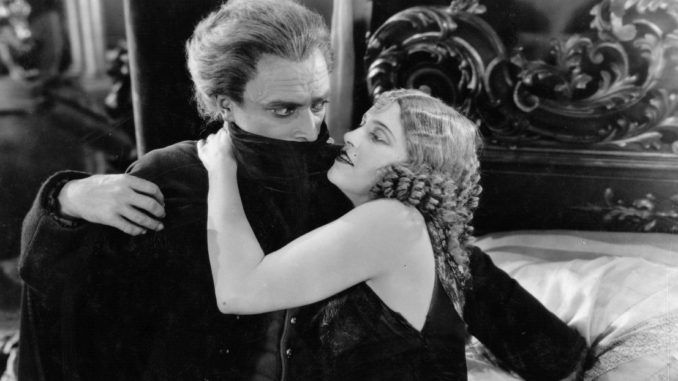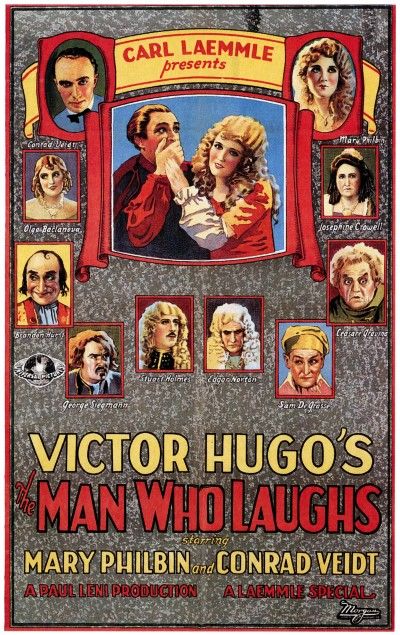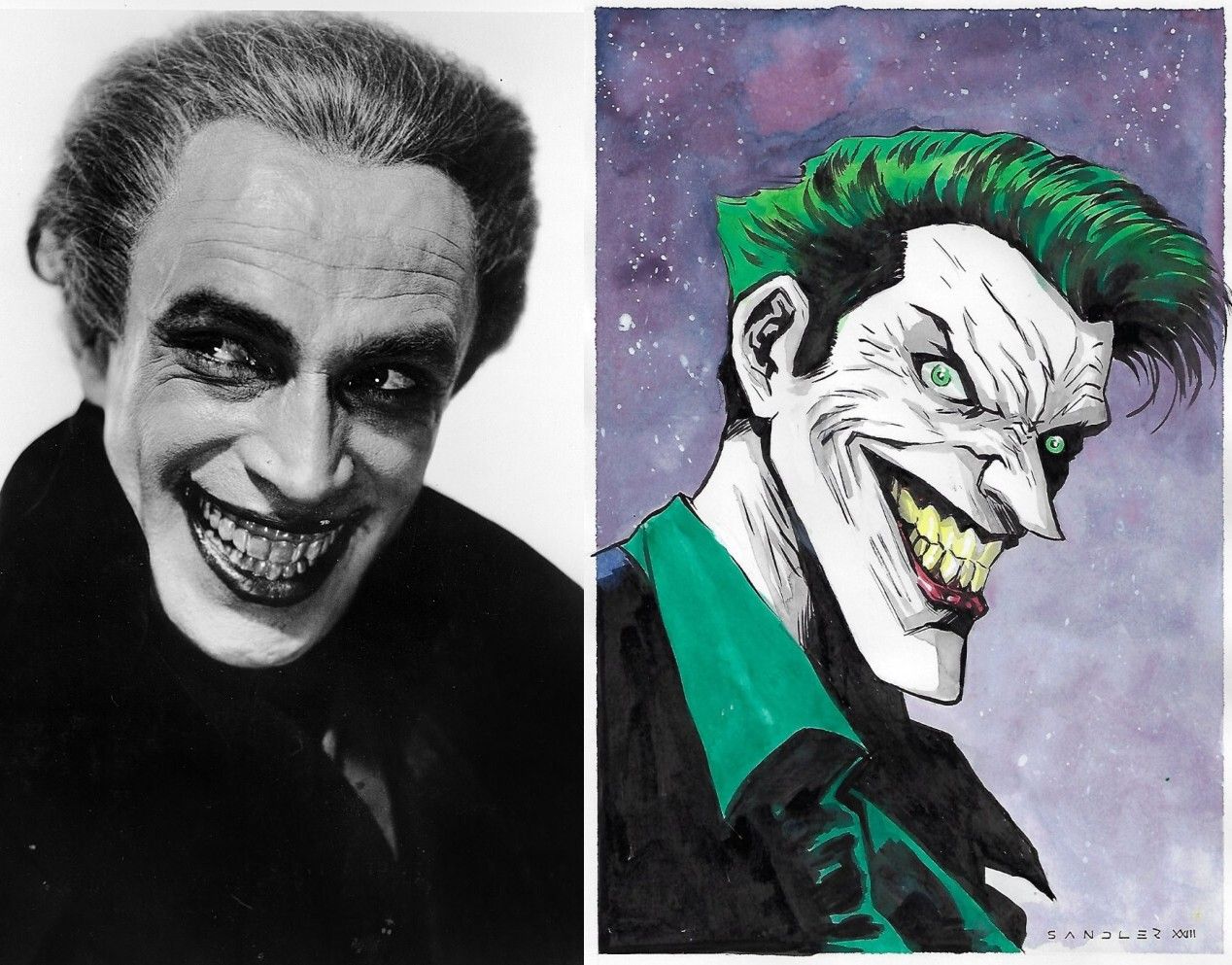
Rating: C+
Dir: Paul Leni
Star: Conrad Veidt, Mary Philbin, Cesare Gravina, Olga Baclanova
There’s one film I wanted to review for this year, but was unable to cover. The Terror, directed by Roy Del Ruth, was released on September 6th, and is of note for being the first all-talking horror film (and also the first sound film with a background score). It came out using the Vitaphone system, on which audio was played using oversized gramophone records. But because this was the early days of sound cinema, it was also released in a silent version. However, neither edition has survived, and it’s considered a lost film. Outside of London After Midnight, it is perhaps the Holy Grail of missing horror cinema, though is much less well known than other titles of the time.
The Terror is arguably the first slasher movie. Set in an English manor house which has been converted to an inn, the guests are being killed off by an unknown killer known as “The Terror”. The residents include a medium, a detective from Scotland Yard and a couple of ex-cons, whose numbers are thinned over the course of the night, before The Terror’s identity is revealed. However, perhaps its loss is for the best, despite being based on a play by Edgar Wallace, since contemporary opinion at the time seems to have been scathing. “The universal opinion of London critics is that The Terror is so bad that it is almost suicidal. They claim that it is monotonous, slow, dragging, fatiguing and boring.” Well, okay then.
 The Man Who Laughs it is then: no sound, but it has survived, in a rather decent print as well. If the film itself has largely been forgotten, compared to other classics of the silent era, its impact on popular culture exceeds many of its contemporaries. For its central character, the surgically disfigured Gwynplaine, was undeniably a significant influence on one of the best-known comic-book characters of all time: Batman’s nemesis, The Joker. While creators Bill Finger, Bob Kane, and Jerry Robinson disagree on the details of the character’s conception, they all agree that his look was inspired by a still from the movie. The similarity is obvious (below), and was explicitly acknowledged in the title of 2005’s graphic novel, Batman: The Man Who Laughs.
The Man Who Laughs it is then: no sound, but it has survived, in a rather decent print as well. If the film itself has largely been forgotten, compared to other classics of the silent era, its impact on popular culture exceeds many of its contemporaries. For its central character, the surgically disfigured Gwynplaine, was undeniably a significant influence on one of the best-known comic-book characters of all time: Batman’s nemesis, The Joker. While creators Bill Finger, Bob Kane, and Jerry Robinson disagree on the details of the character’s conception, they all agree that his look was inspired by a still from the movie. The similarity is obvious (below), and was explicitly acknowledged in the title of 2005’s graphic novel, Batman: The Man Who Laughs.
There’s also some resonance in background, with both being emotionally disfigured on the inside, in addition to the obvious physical damage. How people react to them feeds into their internal turmoil too. But the big difference is that, in The Man Who Laughs, Gwynplaine (Veidt) – and I’m invoking the statute of limitations on spoilers here – is able to overcome things in the end, with the aid of the love of a good woman, Dea (Philbin). The fact she’s blind and thus unaware of his disfigurement, is kinda deemed irrelevant. Joker: Folie a Deux went down a similar road, but ended up at a completely different destination. Indeed, Laughs is not dissimilar to Phantom of the Opera – though, again, with a happier ending, and was originally intended as a vehicle for Lon Chaney.
It begins in 17th-century England, where King James II captures and executes an enemy nobleman, Lord Clancharlie. The Lord’s son, Gwynplaine, is handed over to the Comprachicos, a tribe of gypsies that according to the film are “traders in stolen children,” who “carve the living flesh of these children and transform them into monstrous clowns and jesters.” That’s pretty damn cool for gyppos, I’d say. But sadly, it appears to have been wholly invented by author Victor Hugo, who wrote the book on which this film is based. They get exiled, and leave the young Gwynplaine behind, his face mutilated into a permanent grin. He saves a blind baby, Dea, and they are in turn rescued and brought up by the kindly Ursus (Gravina).
He is a philosopher-showman, a career path sadly no longer available to graduates with arts degrees, and owns an unfortunately-named dog called Homo, which leads to some amusing intertitles. Ursus travels the land, putting on shows with Gwynplaine and Bea. But King James’s jester recognizes Gwynplaine, and tries to blackmail Duchess Josiana. She usurped Lord Clancharlie’s estates, and would be in trouble if his living heir came forward. The Duchess is played by Baclanova, in a gloriously slutty performance, like Madonna in heat, which could only have been permitted in the pre-Hays Code era. If her name seems familiar, she played the similarly sketchy trapeze artist, Cleopatra, in Freaks. Baclanova was known as “the Russian tigress” – Dyanne Thorne take note – though struggled to make the transition to sound film.
 Her character here is not too different from the one in Freaks either. For the Duchess looks to secure her estates by swooping in and taking Gwynplaine away from Dea, so she can marry the genuine Clancharlie heir. Before the end, Gwynplaine has been thrown in jail, made a peer of the realm, rejected his title in the House of Lords, been rescued by Homo, and finally, reunited with Dea on a boat sailing away from England. In terms of genre, it could be seen as early body horror, and an ancestor of The Ugly Stepsister. A clear theme is how the outside appearance can impact the inside, though it suggests moral fortitude (and that love of a good woman) can overcome those pressures. But there are some chunks which are pretty damn creepy, such as the young Gwynplaine making his way across a snowy landscape, decorated with corpses dangling off gibbets.
Her character here is not too different from the one in Freaks either. For the Duchess looks to secure her estates by swooping in and taking Gwynplaine away from Dea, so she can marry the genuine Clancharlie heir. Before the end, Gwynplaine has been thrown in jail, made a peer of the realm, rejected his title in the House of Lords, been rescued by Homo, and finally, reunited with Dea on a boat sailing away from England. In terms of genre, it could be seen as early body horror, and an ancestor of The Ugly Stepsister. A clear theme is how the outside appearance can impact the inside, though it suggests moral fortitude (and that love of a good woman) can overcome those pressures. But there are some chunks which are pretty damn creepy, such as the young Gwynplaine making his way across a snowy landscape, decorated with corpses dangling off gibbets.
Despite Baclanova’s best efforts, this definitely feels like it drags in the middle. Its running time of 110 minutes makes it a real chonker in comparison to others we’ve seen, and I felt the plot was needlessly complicated. However, it both starts and ends well enough, and the rest of the performances are generally good. Veidt’s torment is easily felt, while Philbin makes a classic silent movie heroine, who will stand by her man regardless of the circumstances (even if she’s not exactly fully-informed!). Sadly, director Leni died the following year, of sepsis resulting from an untreated tooth infection. Remember to floss, kids.
This article is part of our October 2025 feature, 31 Days of Vintage Horror.
